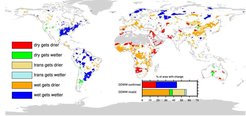Local climate contrary to predictions

In a recent study in Nature Geoscience published September 14th, this formula has been challenged by a team of climate researchers from ETH Zurich and MPI-BGC director Markus Reichstein. Traditional analyses reliably describe climate characteristics above the ocean, but are erroneous over land. In their new study, the authors take into account the specific climatic properties of land surfaces, where the amount of available water is limited when compared with the ocean.
The scientists used measurement data compiled solely on land, such as rainfall, actual evaporation and potential evaporation. The data, derived from various sources including MPI-BGC, was newly combined such that trends in terms of a region’s humidity and dryness could be extracted.
The evaluation shows no obvious trend towards a drier or wetter climate across three-quarters of the land area. For the remaining quarter, half of the surface area, i.e. one-eighth of the total landmass, follows the DDWW principle. The other half, however, contradicts the DDWW rule.
Original publication:
Greve P, Orlowsky B, Müller B, Sheffield J, Reichstein M, Seneviratne SI. Global assessment of trends in wetting and drying over land.
Nature Geoscience, Advanced Online Publication 14th September 2014.
DOI: 10.1038/ngeo2247
Adapted from a ETH Zurich press release (P. Rüegg), for further details see:
